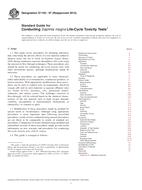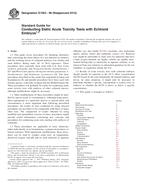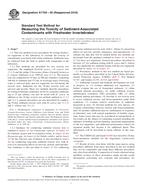Potřebujeme váš souhlas k využití jednotlivých dat, aby se vám mimo jiné mohly ukazovat informace týkající se vašich zájmů. Souhlas udělíte kliknutím na tlačítko „OK“.
ASTM E1218-04(2012)
Standard Guide for Conducting Static Toxicity Tests with Microalgae (Withdrawn 2021)
Automaticky přeložený název:
Standardní příručka pro dirigování statické zkoušky toxicity s řas
NORMA vydána dne 1.12.2012
Informace o normě:
Označení normy: ASTM E1218-04(2012)
Poznámka: NEPLATNÁ
Datum vydání normy: 1.12.2012
Kód zboží: NS-40898
Počet stran: 14
Přibližná hmotnost: 42 g (0.09 liber)
Země: Americká technická norma
Kategorie: Technické normy ASTM
Kategorie - podobné normy:
Anotace textu normy ASTM E1218-04(2012) :
Keywords:
algae, algal-toxicity testing, aquatic plants, aquatic toxicity testing, microalgae, ICS Number Code 07.100.20 (Microbiology of water)
Doplňující informace
| Significance and Use | ||||||||||||||||||||||||||||||||||||||||||||||||||||||||||||||||||||||||||||||||||||||||||||||||
|
5.1 Tests with algae provide information on the toxicity of test materials to an important component of the aquatic biota and might indicate whether additional testing (1)4 is desirable. 5.2 Algae are ubiquitous in aquatic ecosystems, where they incorporate solar energy into biomass, produce oxygen, function in nutrient cycling and serve as food for animals. Because of their ecological importance, sensitivity to many toxicants, ready availability, ease of culture, and fast growth rates (rendering it possible to conduct a multi-generation test in a short period of time), algae are often used in toxicity testing. 5.3 Results of algal toxicity tests might be used to compare the sensitivities of different species of algae and the toxicities of different materials to algae and to study the effects of various environmental factors on results of such tests. 5.4 Results of algal toxicity tests might be an important consideration when assessing the hazards of materials to aquatic organisms (See Guide E1023) or deriving water quality criteria for aquatic organisms (2). 5.5 Results of algal toxicity tests might be useful for studying biological availability of, and structure-activity relationships between, test materials. 5.6 Results of algal toxicity tests will depend on the temperature, composition of the growth medium, and other factors. These tests are conducted in solutions that contain concentrations of salts, minerals, and nutrients that greatly exceed those in most surface waters. These conditions may over- or under-estimate the effects of the test material if discharged to surface waters. |
||||||||||||||||||||||||||||||||||||||||||||||||||||||||||||||||||||||||||||||||||||||||||||||||
| 1. Scope | ||||||||||||||||||||||||||||||||||||||||||||||||||||||||||||||||||||||||||||||||||||||||||||||||
|
1.1 This guide covers procedures for obtaining laboratory data concerning the adverse effects of a test material added to growth medium on growth of certain species of freshwater and saltwater microalgae during a static exposure. These procedures will probably be useful for conducting short-term toxicity tests with other species of algae, although modifications might be necessary. Although the test duration is comparable to an acute toxicity test with aquatic animals, an algal toxicity test of short duration (72, 96 or 120 h) allows for examination of effects upon multiple generations of an algal population and thus should not be viewed as an acute toxicity test. 1.2 Other modifications of these procedures might be justified by special needs or circumstances. Although using appropriate procedures is more important than following prescribed procedures, results of tests conducted using unusual procedures are not likely to be comparable to results of many other tests. Comparison of results obtained using modified and unmodified versions of these procedures might provide useful information concerning new concepts and procedures for conducting toxicity tests with microalgae. 1.3 These procedures are applicable to many chemicals, either individually or in formulations, commercial products, or known mixtures. With appropriate modifications, these procedures can be used to conduct tests on temperature, and pH and on such materials as aqueous effluents (see also Guide E1192), leachates, oils, particulate matter, sediments, and surface waters. Static tests might not be applicable to materials that are highly volatile, are rapidly biologically or chemically transformed in aqueous solutions, or are removed from test solutions in substantial quantities by the test vessels or organisms during the test. However, practical flow-through test procedures with microalgae have not been developed. 1.4 Results of tests using microalgae should usually be reported in terms of the 96-h (or other time period) IC50 (see 3.2.5) based on reduction in growth. In some situations, it might only be necessary to determine whether a specific concentration unacceptably affects the growth of the test species or whether the IC50 is above or below a specific concentration. 1.5 This guide is arranged as follows:
1.6 This standard does not
purport to address all of the safety concerns, if any, associated
with its use. It is the responsibility of the user of this standard
to establish appropriate safety and health practices and determine
the applicability of regulatory limitations prior to use.
Standard Guide for Assessing the Hazard
of a Material to Aquatic Organisms and Their Uses Standard Practice for Statistical
Analysis of Toxicity Tests Conducted Under ASTM Guidelines Standard Terminology Relating to
Biological Effects and Environmental Fate Standard Practice for Use of the
Internation System of Units (SI) (the Modernized Metric System)
(Withdrawn 1997) Standard Guide for Disposal of Laboratory
Chemicals and Samples Standard Guide for Conducting Acute
Toxicity Tests on Aqueous Ambient Samples and Effluents with
Fishes, Macroinvertebrates, and Amphibians Standard Practices for Measurement of
Chlorophyll Content of Algae in Surface Waters Standard Terminology Relating to Water
(Includes all amendments and changes 2/14/2024). Standard Guide for Conducting Acute
Toxicity Tests on Test Materials with Fishes, Macroinvertebrates,
and Amphibians (Includes all amendments and changes 2/22/2023). Standard Guide for Use of Lighting in
Laboratory Testing Standard Practice for Algal Growth
Potential Testing with Pseudokirchneriella subcapitata (Includes
all amendments and changes 1/20/2022). |
Podobné normy:
Historická
1.10.2007
Historická
1.12.2012
Historická
1.3.2013
Historická
1.3.2013
Historická
1.12.2012
Historická
1.9.2010
Doporučujeme:
Aktualizace technických norem
Chcete mít jistotu, že používáte pouze platné technické normy?
Nabízíme Vám řešení, které Vám zajistí měsíční přehled o aktuálnosti norem, které používáte.
Chcete vědět více informací? Podívejte se na tuto stránku.



 ASTM E1023-84(2007)..
ASTM E1023-84(2007).. ASTM E1193-97(2012)..
ASTM E1193-97(2012).. ASTM E1295-01(2013)..
ASTM E1295-01(2013).. ASTM E1562-00(2013)..
ASTM E1562-00(2013).. ASTM E1563-98(2012)..
ASTM E1563-98(2012).. ASTM E1706-05(2010)..
ASTM E1706-05(2010)..
 Cookies
Cookies
